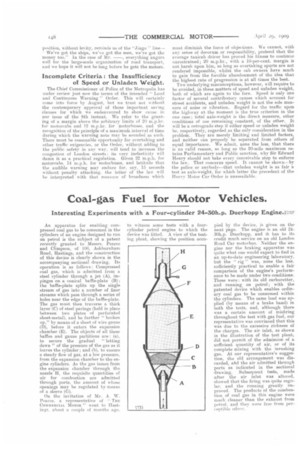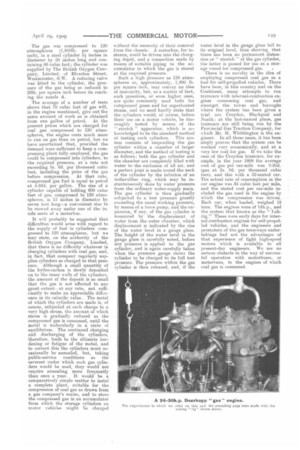Coal-gas Fuel for Motor Vehicles.
Page 2

Page 3

If you've noticed an error in this article please click here to report it so we can fix it.
Interesting Experiments with a Four-cylinder 24-30h.p. Duerkopp Engine.mco
An apparatus for enabling compressed coal gas to be consumed in the cylinders of an engine designed to run on petrol is the subject of a patent recently granted to Messrs. Pearce and Climpson, of 106, Asliburnham Road, Hastings, and the construction of this device is clearly shown in the accompanying sectional drawing. Its operation is as follows : Compressed coal gas, which is admitted from a steel cylinder through a jet (A), impinges on a conical baffle-plate (B); the baffle-plate splits up the single stream of gas into a number of finer streams which pass through a series of holes near the edge of the baffle-plate. The gas must then traverse a thick layer (C) of steel parings (held in place between two plates of perforated sheet-metal), and be further " broken up," by means of a sheet of wire gauze (D), before it enters the expansion chamber (E). The objects of all these baffles and gauze partitions are: (a), to secure the gradual "letting down " of the pressure of the gas as it leaves the cylinder ; and (b), to ensure a steady low of gas, at a low pressure, from the expansion chamber to the engine cylinders. As the gas issues from the expansion chamber through the nozzle H, the requisite quantities of air for combustion are admitted through ports, the amount of whose openings may be regulated by means of a sleeve (0).
On the invitation of Mr. A. W. Pearce. a representative of COMMERCIAL MOTOR " went to Hastings. about a couple of months ago. to witness some tests with a fourcylinder petrol engine to which the device was fitted. A view of the testing plant, showing the position occu
pied by the device, is given on the next page. The engine is an old 2430h.p. Duerkopp, and it has to its. credit much service on an old London Road Car motorbus. Neither the engine nor the braking apparatus was quite what one would expect to find in an up-to-date engineering laboratory, but the " rig " was' none the less, sufficiently practical to enable a fair comparison of the engine's performance to be made under two conditions_ These were : with its old carburetter, and running on petrol ; with the patented device which enables ordinary coal gas to be consumed within the cylinders. The same load was applied (by means of a brake band) in both the tests, and, although there was a certain amount of misfiring throughout the test with gas fuel, our representative was convinced that this was due to the excessive richness of the charges. The air inlet, as shown in the illustration of the test plant, did not permit of the admission of a sufficient quantity of air, or of its. complete mixing with the inrushing gas. At our representative's suggestion, the old arrangement was discarded, and the air admitted through ports as indicated in the sectional drawing. Subsequent tests, made after the air inlet was altered, showed that the firing was quite regular, and the running greatly improved. The products of the combustion of coal gas in this engine were much cleaner than the exhaust from petrol, and they were free from perceptible odour_
The gas was compressed to 120 atmospheres (1,8001b. per square inch), in a steel cylinder 54 inches in diameter by 50 inches long and containing 60 cubic feet; the cylinder was supplied by The British Oxygen Company, Limited, of Elverton Street, Westminster, S.W. A reducing valve wa,s fitted to the cylinder, the pressure of the gas being so reduced to 201b. per square inch before its reaching the nozzle A.
The average of a number of tests shows that 70 cubic feet of gas will, in the engine mentioned, give out the same amount of work as is obtained from one gallon of petrol. At the present prices which are charged for coal gas compressed to 120 atmospheres, the engine costs much more to run on gas than on petrol, but we have ascertained that, provided the demand were sufficient to keep a compressing plant fully employed, the gas could be compressed into cylinders, to the required pressure, at a rate not exceeding Sc. 6d, per thousand cubic feet, including the price of the gas before compression. At that rate, compressed gas fuel is equal to petrol at 4.68d. per gallon. The size of a cylinder capable of holding 600 cubic feet of gas, compressed to 120 atmospheres, is 15 inches in diameter by seven feet long—a convenient size to be stowed away under one of the inside seats of a motorbus.
It will probably be suggested that difficulties would arise with regard to the supply of fuel in cylinders compressed to 120 atmospheres, but we may state, on the authority of the British Oxygen Company, Limited, that there is no difficulty whatever in charging cylinders with coal gas, and, in fact, that company regularly supplies cylinders so charged to that pressure, Although a small quantity of the hydro-carbon is slowly deposited on to the inner walls of the cylinders, the amount of the deposit is so small that the gas is not affected to any great extent—at any rate, not sufficiently to make an appreciable difference in its calorific value. The metal of which the cylinders are made is, of course, subjected at each charge to a very high stress, the amount of which stress is gradually reduced as the compressed gas is consumed, until the metal is molecularly in a state of equilibrium. The continued charging and discharging of the cylinders, therefore, leads to the ultimate hardening or fatigue of the metal, and to correct this the cylinders must occasionally be annealed, but, taking public-service conditions as the severest under which such gas cylinders would be used, they would not require annealing more frequently than once a year. It would be a comparatively simple matter to instal a complete plant, suitable for the compression of coal gas as drawn from a gas company's mains, and to store the compressed gas in an accumulator from which the storage cylinders on motor vehicles might be charged
without the necessity of their removal from the chassis_ A motorbus, for instance, could be driven into the charging depot, and a connection made by means of suitable piping to the accumulator in which the gas is stored at the required pressure.
Such a high pressure as 120 atmospheres or, approximately, 1,800 lb. per square inch, may convey an idea of insecurity, but, as a matter of fact, such pressures, or even higher ones, are quite commonly used both for compressed gases and for superheated steam, and we need hardly state that the cylinders would, of course, before their use on a motor vehicle, be thoroughly tested by means of the " stretch " apparatus, which is acknowledged to be the standard method of testing such cylinders. This system consists of suspending the gas cylinder within a chamber of larger diameter, and the method of testing is as follows: both the gas cylinder and the chamber are completely filled with water to the exclusion of all air, and a perfect joint is made round the neck of the cylinder by the iodation of an indiarubber ring, which may be instantaneously done by water pressure from the ordinary water-supply main. The gas cylinder is then gradually subjected to a test pressure greatly exceeding the usual working pressure, by means of a force pump, and the expansion, if any, of the gas cylinder is measured by the displacement of water from the outer chamber, which displacement is indicated by the rise of the water level in a gauge glass. The height of the water level in the gauge glass is carefully noted, before any pressure is applied to the gas cylinder, and is again carefully taken when the pressure gauge shows the cylinder to be charged to its full test pressure. The pressure within the gas cylinder is then released, and if the water level in the gauge glass fall to its original level, thus showing that there has been no permanent distension or " stretch " of the gas cylinder, the latter is passed for use as a storage vessel for compressed gas.
There is no novelty in the idea of employing compressed coal gas as a fuel for self-propelled vehicles. There have been, in this country and on the Continent, many attempts to run tramcars with internal-combustion engines consuming coal gas, and amongst the towns and boroughs where the system has been given a trial are Croydon, Blackpool and Neath at the last-named place, gas tramcars are still being run by the Provincial Cas Traction Company, for which Mr. M. Whittington is the engineer. In all these cases, it has been amply proven that the system can be worked very economically, and at a very low cost for gas. If we take the case of the Croydon tramcars, for example, in the year 1898 the average cost of gas per car-mile was 0.95d. (gas at 2s. 9d. per thousand cubic feet); and this with a 52-seated car. The actual rate of consumption in the car engine was 34 cubic feet per mile, and the stated cost per car-mile included the gas used in the engine by which the compression was driven. Each car, when loaded, weighed 12 tons. The engines were of 14h.p., and the system that known as the "
rig." These were early days for internal-combustion engines for self-propelled vehicles, and the engineers and promoters of the gas tramways undertakings had not the advantages of that experience of light high-speed motors which is available to all present-day engineers. We see no serious obstacle in the way of successful operation with motorbuses, or niotorvans, in the engines of which coal gas is consumed.




















